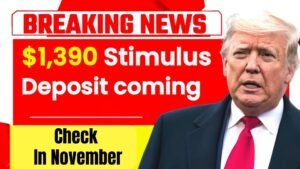What if you logged into your bank account one morning and saw $1,390 from the Internal Revenue Service (IRS) sitting in there — no strings, no extra paperwork? It sounds too good to be true. Yet right now, whispers are swelling across the country about a November 2025 direct-deposit payment that could land in eligible Americans’ accounts. Read on to uncover the full story, check if you’re eligible, and learn the steps to claim your payout.
What It Is: The $1,390 Direct Deposit Relief Payment
In short, the payment being discussed is NOT a brand-new entitlement program announced by Congress, but rather a possible catch-up or credit payment tied to previously unclaimed taxpayer benefits. Although the IRS has denied any new universal $1,390 payment, many news outlets suggest the figure refers to the average amount owed under the Recovery Rebate Credit (RRC) from earlier stimulus rounds.
This distinction matters: It means the payment isn’t guaranteed unless you meet specific criteria — and you must act soon.
History & Background: How Did We Get Here?
Back when stimulus checks were sent during the pandemic, many taxpayers either didn’t file or didn’t claim their full credit. The RRC allowed certain filers to receive missing amounts later. Now in 2025, a resurgence of claims and media reports have revived this topic. The IRS is currently sorting through unclaimed credits from 2021 and earlier years — some of which may add up to roughly $1,390 for eligible individuals.
Rumors of a fresh “$1,390 stimulus payment” spread fast, but official statements clarify: it’s not a new blanket payment.
Why This Matters Today
With cost-of-living pressures rising, a direct deposit of $1,390 could make the difference between covering a month’s bills or falling behind. Whether you think of it as tax relief, unclaimed credit, or a hidden windfall, knowing your eligibility can mean real benefit rather than missed opportunity.
Hundreds of thousands may qualify — and unlike past stimulus checks with broad eligibility, this is targeted, so timing and detail matter.
How to Engage & Maximize Your Benefit
Step 1: File or Review Your Tax Return
If you never filed a 2021 tax return but were eligible, you may need to file now to claim the missing credit.
Step 2: Check Your Direct-Deposit or Mailing Info
Ensure the IRS has your correct bank account or address — delays often stem from outdated info.
Step 3: Use ONLY Official IRS Tools
Visit the IRS website and use “Where’s My Refund” or the RRC tool. Avoid phishing scams or sites claiming “click to claim $1,390 now!”
Step 4: Keep Proof & Documentation
If you receive a notice from the IRS, retain it in case you need to verify your claim or handle follow-up.
Eligibility Snapshot
| Filing Status | Adjusted Gross Income (AGI) Limit* | Typical Payment |
|---|---|---|
| Single | Below ~$75,000 | ~$1,390 |
| Married Filing Jointly | Below ~$150,000 | ~$2,780 |
| Head of Household | Below ~$112,500 | ~$1,390 |
| *Approximate based on previous RRC thresholds. |
Payment & Delivery Methods
| Method | Typical Timing | Notes |
|---|---|---|
| Direct Deposit | 1-3 business days | Fastest, once bank info is validated |
| Paper Check | 4-10 days after deposit | Slower, risk of lost/misdirected mail |
| Debit Card | 7-14 days | Rare, used for unbanked recipients |
Notable Facts & Records
- Official IRS statements state no new blanket $1,390 payment was authorized — the number refers to unclaimed credits.
- Some websites misrepresent the $1,390 figure — treat viral posts with caution and check the IRS site first.
- The average household spending on groceries is around $1,200/month, making $1,390 nearly equivalent to a full month’s food budget.
Expert Tips & Insider Advice
- Set up automatic direct deposit if not already done — it helps avoid delays or lost checks.
- If you didn’t receive the full stimulus in the past, check the 2021 RRC eligibility, even if you assumed you received everything.
- Beware of scams: the IRS will never call you to ask for banking info or payment to claim your money.
- Track your status: Use the official IRS “Get My Payment” or “Where’s My Refund” tools for accurate updates.
Frequently Asked Questions (FAQs)
Q: Is the payment automatic for everyone?
A: Not necessarily. Only those eligible and with valid tax records may receive the amount — some will need to file.
Q: Can I receive $1,390 if I already got stimulus payments in 2021?
A: If you received full payments previously, you likely won’t receive additional funds related to the RRC.
Q: What should I do if I don’t see the payment by November?
A: Verify your filing status, bank account info, and use official IRS tools. Consider filing an overdue return if applicable.
Conclusion: Action Time — Don’t Let It Slip Away
This isn’t just a headline—it’s a chance. The “$1,390 direct deposit relief” may not be a brand-new universal stimulus check, but for many eligible Americans, it represents money owed that’s quietly waiting. Do your homework, verify your status, and file any missing returns. The final twist? If you proactively act, this might be one of the most overlooked opportunities of 2025 to get real cash in hand. Check today—you might find a welcome surprise in your account.




